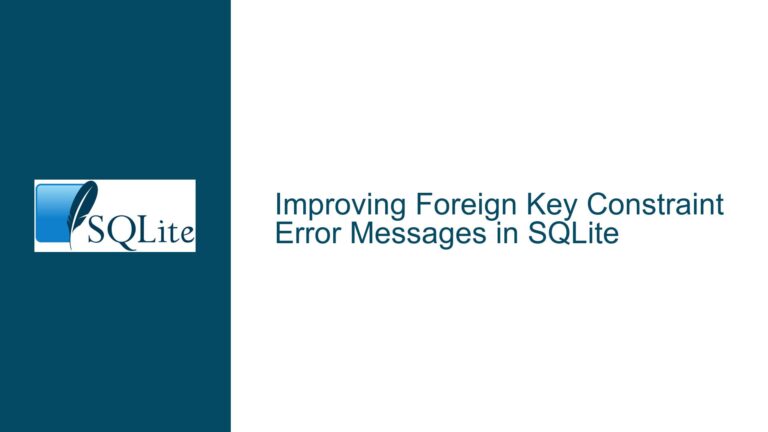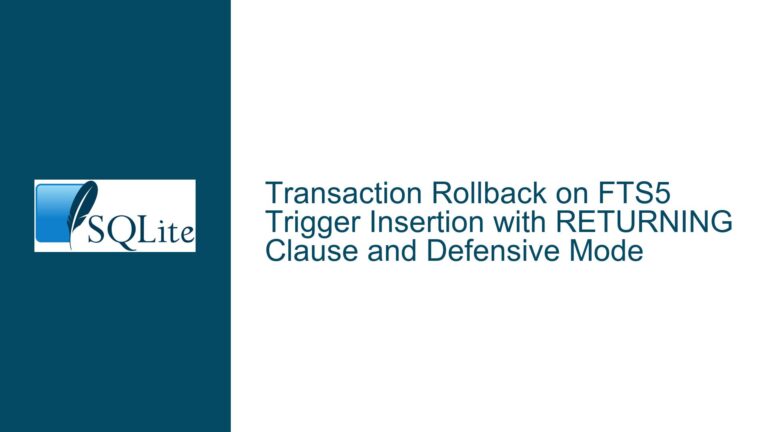Foreign Key Constraint Violation in SQLite 3.48 During Changeset Application
Understanding the Foreign Key Constraint and Deferred Behavior in SQLite
The core issue revolves around a foreign key constraint violation that occurs when applying a changeset in SQLite, specifically after upgrading to version 3.48. The scenario involves two tables: data and tags. The data table has a primary key id, and the tags table has a foreign key dataId that references data(id). The foreign key is defined with ON DELETE CASCADE and is DEFERRABLE INITIALLY DEFERRED. This setup ensures that when a row in the data table is deleted, all corresponding rows in the tags table are also deleted. However, the constraint checking is deferred until the transaction is committed.
The process involves starting a transaction, inserting rows into the data table, creating a session, inserting rows into the tags table, generating a changeset, deleting the session, removing a row from the data table, applying the changeset (which includes the tags), and finally committing the transaction. Prior to SQLite 3.48, this workflow functioned without issues. However, after the upgrade, a foreign key constraint violation occurs during the commit phase.
The confusion arises from the behavior of deferred foreign key constraints and the timing of the cascade delete operation. The expectation was that the cascade delete would only take effect at commit time, allowing the changeset to be applied without violating the foreign key constraint. However, the cascade delete actually occurs immediately when the row in the data table is deleted, even though the constraint check is deferred. This means that when the changeset is applied, it attempts to reinsert rows into the tags table that reference a non-existent row in the data table, leading to a foreign key violation.
The Role of Sessions and Changesets in SQLite
Sessions and changesets in SQLite are powerful tools for tracking and applying changes to a database. A session object records changes made to a database within a specific scope, and a changeset is a serialized representation of these changes. Changesets can be applied to other databases, making them useful for synchronization and replication scenarios.
In this case, the session is used to track the insertion of rows into the tags table. The changeset generated from this session is then applied after the corresponding row in the data table has been deleted. The expectation was that the cascade delete would only take effect at commit time, allowing the changeset to be applied without issues. However, the immediate cascade delete behavior means that the changeset attempts to reinsert rows into the tags table that no longer have a valid parent in the data table, resulting in a foreign key constraint violation.
The issue is further complicated by the fact that the behavior changed in SQLite 3.48 due to fixes in the handling of foreign keys during changeset application. Prior to this version, the cascade delete might not have been immediately enforced, allowing the changeset to be applied without triggering a foreign key violation. This change in behavior highlights the importance of understanding the nuances of deferred foreign key constraints and the timing of cascade operations.
Resolving Foreign Key Constraint Violations in Changeset Application
To address the foreign key constraint violation when applying changesets, it is essential to understand the timing of cascade deletes and the enforcement of foreign key constraints. The cascade delete operation occurs immediately when the parent row is deleted, even though the constraint check is deferred until commit time. This means that any attempt to reinsert rows into the tags table that reference a deleted row in the data table will result in a foreign key violation.
One approach to resolving this issue is to ensure that the changeset does not include rows that reference deleted parent rows. This can be achieved by carefully managing the order of operations within the transaction. For example, the changeset should be applied before the parent row in the data table is deleted. This ensures that the changeset is applied while the parent row still exists, avoiding the foreign key violation.
Another approach is to use a different strategy for handling the deletion of parent rows and the application of changesets. Instead of relying on cascade deletes, the application could explicitly delete the corresponding rows in the tags table before applying the changeset. This ensures that the changeset does not attempt to reinsert rows that would violate the foreign key constraint.
In cases where multiple changesets need to be applied, it is crucial to enforce constraints after each changeset application to ensure that no foreign key violations are introduced. This can be done by committing the transaction after each changeset application and starting a new transaction for the next changeset. This approach ensures that any foreign key violations are detected and handled immediately, rather than being deferred until the final commit.
Finally, it is important to stay informed about changes in SQLite’s behavior, especially when upgrading to new versions. The change in behavior in SQLite 3.48 highlights the need to thoroughly test database operations after an upgrade to ensure that they continue to function as expected. In this case, the fix in SQLite 3.48 corrected a bug in the handling of foreign keys during changeset application, ensuring that foreign key constraints are properly enforced.
By understanding the timing of cascade deletes, the enforcement of foreign key constraints, and the behavior of sessions and changesets, it is possible to resolve foreign key constraint violations and ensure the integrity of the database. Careful management of transaction order, explicit handling of deletions, and thorough testing after upgrades are key strategies for avoiding and resolving these issues.






